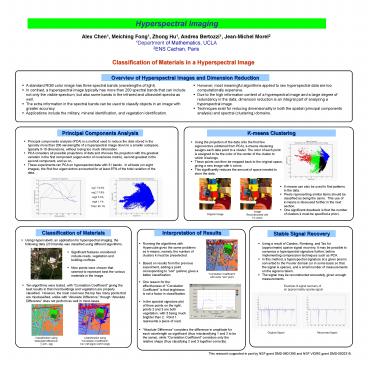Hyperspectral Imaging PowerPoint PPT Presentation
1 / 1
Title: Hyperspectral Imaging
1
Hyperspectral Imaging
Alex Chen1, Meiching Fong1, Zhong Hu1, Andrea
Bertozzi1, Jean-Michel Morel2 1Department of
Mathematics, UCLA 2ENS Cachan, Paris
Classification of Materials in a Hyperspectral
Image
Overview of Hyperspectral Images and Dimension
Reduction
- However, most meaningful algorithms applied to
raw hyperspectral data are too computationally
expensive. - Due to the high information content of a
hyperspectral image and a large degree of
redundancy in the data, dimension reduction is an
integral part of analyzing a hyperspectral image. - Techniques exist for reducing dimensionality in
both the spatial (principal components analysis)
and spectral (clustering) domains.
- A standard RGB color image has three spectral
bands (wavelengths of light). - In contrast, a hyperspectral image typically has
more than 200 spectral bands that can include not
only the visible spectrum, but also some bands in
the infrared and ultraviolet spectra as well. - The extra information in the spectral bands can
be used to classify objects in an image with
greater accuracy. - Applications include the military, mineral
identification, and vegetation identification.
Principal Components Analysis
K-means Clustering
- Principal components analysis (PCA) is a method
used to reduce the data stored in the typically
more than 200 wavelengths of a hyperspectral
image down to a smaller subspace, typically 5-10
dimensions, without losing too much information. - PCA considers all possible projections of data
and chooses the projection with the greatest
variation in the first component (eigenvector of
covariance matrix), second greatest in the second
component, and so on. - These experiments ran PCA on hyperspectral data
with 31 bands. In all tests (on eight images),
the first four eigenvectors accounted for at
least 97 of the total variation of the data.
- Using the projection of the data onto the first
few eigenvectors (obtained from PCA), k-means
clustering assigns each data point to a cluster.
The color of each point is assigned to be the
color of the center of the cluster to which it
belongs. - These points can then be mapped back to the
original space, giving a new image with k colors. - This significantly reduces the amount of space
needed to store the data.
- K-means can also be used to find patterns in the
data. - Pixels representing similar items should be
classified as being the same. This use of
k-means is discussed further in the next section. - One significant drawback is that the number of
clusters k must be specified a priori.
eig1 74.0 eig2 17.6 eig3 5.4 eig4 1.1 Total
98.1
Image Reconstructed with 15 colors
Original Image
Classification of Materials
Interpretation of Results
Stable Signal Recovery
- Using Hypercube, an application for
hyperspectral imaging, the following data (210
bands) was classified using different algorithms.
- Using a result of Candes, Romberg, and Tao for
(approximate) sparse signal recovery, it may be
possible to compress a hyperspectral signature
further, before implementing compression
techniques such as PCA. - In this method, a hyperspectral signature at a
given pixel is converted to the Fourier domain
(or in some basis so that the signal is sparse),
and a small number of measurements on the signal
is taken. - The signal may be reconstructed accurately, given
enough measurements.
- Running the algorithms with Hypercube gives the
same problems as k-means, namely, the number of
clusters k must be preselected. - Based on results from the previous experiment,
adding a point corresponding to soil (yellow)
gives a better classification.
- Significant features considered include roads,
vegetation and building rooftops. - Nine points were chosen that seemed to represent
best the various materials in the image.
Correlation Coefficient with extra soil point
- One reason for the effectiveness of Correlation
Coefficient is that brightness is not a factor
in classification. - In the spectral signature plot of three points on
the right, points 2 and 3 are both vegetation,
with 3 being much brighter than 2. Point 1
represents a piece of road.
- Ten algorithms were tested, with Correlation
Coefficient giving the best results in that most
buildings and vegetation are properly classified.
However, the main road near the top has many
points that are misclassified, unlike with
Absolute Difference, though Absolute
Difference does not perform as well in most
cases.
Example of signal recovery of an approximately
sparse signal
- Absolute Difference considers the difference in
amplitude for each wavelength as significant
(thus misclassifying 1 and 2 to be the same),
while Correlation Coefficient considers only
the relative shape (thus classifying 2 and 3
together correctly).
Original Signal
Recovered Signal
Classification using Absolute Difference ?
ref - sig
Classification using Correlation Coefficient
Cov (ref,sig)/(?(ref)?(sig))
This research supported in part by NSF grant
DMS-0601395 and NSF VIGRE grant DMS-0502315.

